All you need to know on how to make the perfect roux and the perfect gumbo roux! Not all roux are created equal, and starting with the right base is the secret to getting flavorful sauces, soups, bisques, gumbos, gravies, and more!
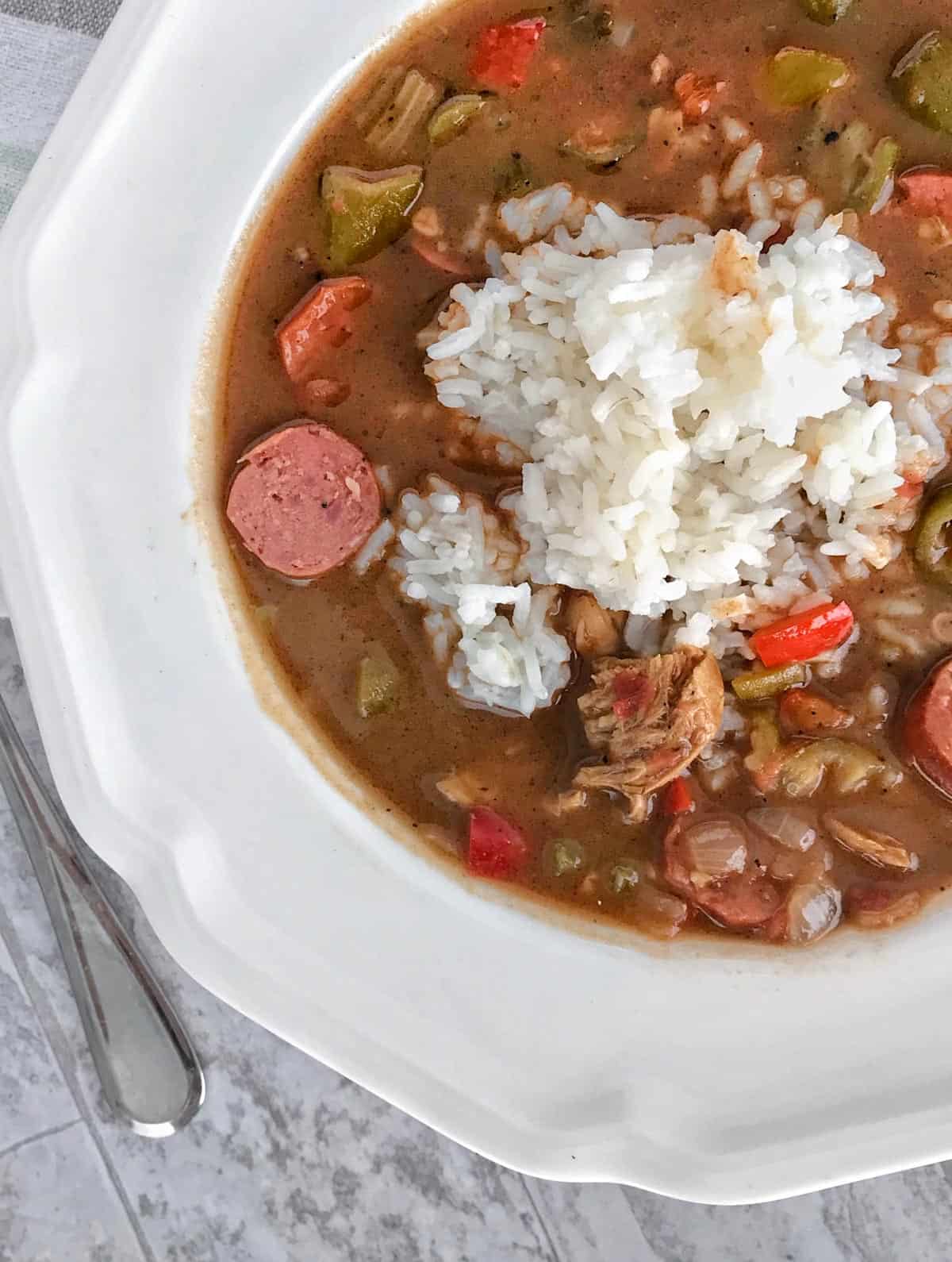
Jump to:
- What is a roux? And what is a roux used for?
- What Goes into this Recipe
- What is the Best Oil for a Roux?
- Best Oil for a Gumbo Roux
- Creole vs. Cajun Roux
- Roux Color Guide
- What Kind of Roux is Right For Your Recipe?
- How to Make a Roux
- Frequently Asked Questions (FAQs)
- Expert Tips
- We think You'll Enjoy These Posts Too:
- The Secret to the Perfect Roux (and the perfect GUMBO ROUX!)
What is a roux? And what is a roux used for?
A roux (pronounced ROO) is a blend of a fat and flour and is used as the basis of sauces and soups. It is used thicken and flavor sauces and soups.
You can use any type of fat, different types of fat will give you different flavors (more on that later). Typically, a roux has equal amounts, a 1:1 ratio, of fat and flour.
Fun Fact: Roux is both singular and plural! Even though it sounds wrong when you’re reading it : )
What Goes into this Recipe
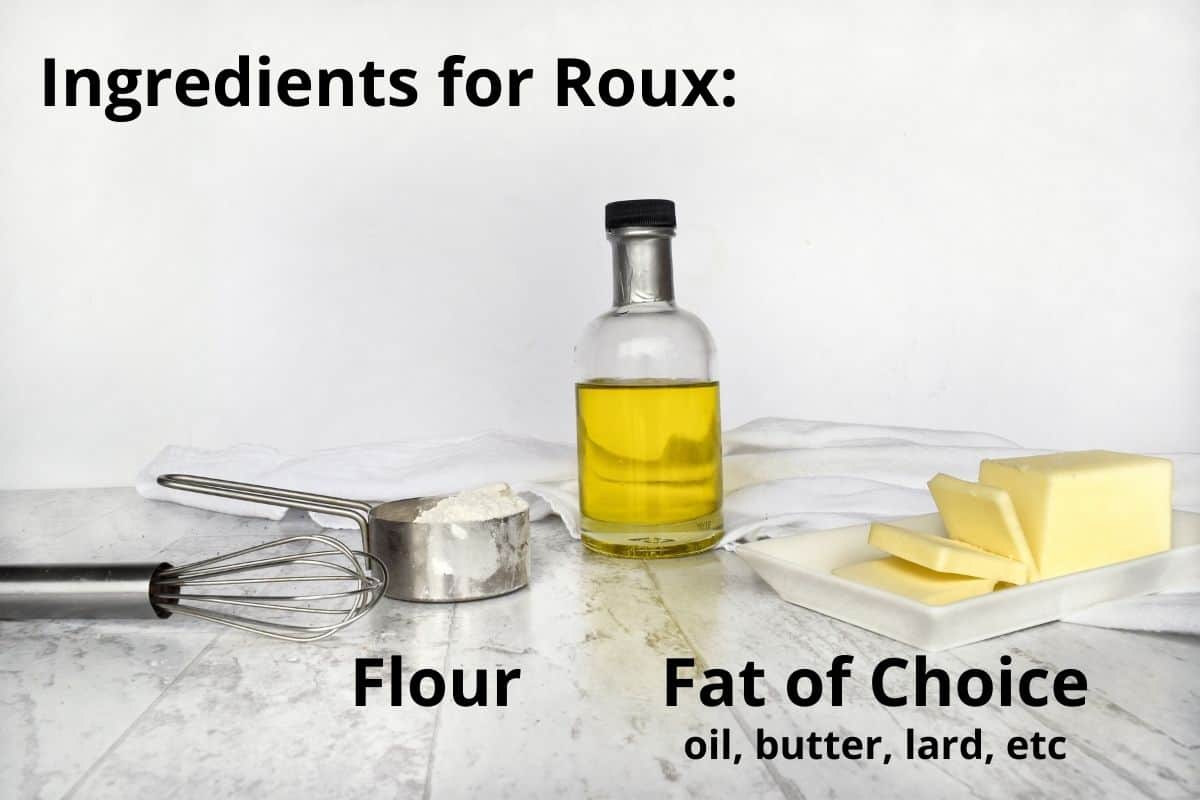
- Flour. All-purpose (white) flour is best for a roux.
- Fat. Butter, oil, lard. A wide variety of fats can be used depending on what kind of roux you are making. See our section below on choosing the right kind of fat for your roux.
- Patience. Yeah, we listed that. A good roux can take time if you’re going for a darker Color. Remember: this is going to be the base of your dish, it needs to be done right!
What is the Best Oil for a Roux?

Things to Consider
When making a roux first ask yourself, what am I using this roux for? Are you using it for a simple country gravy or are you making dark brown roux for a rich gumbo? What you are using your roux for will influence what color of roux you are making and what kind of oil or fat you are selecting for your roux.
Other things you’ll want to consider when selecting the fat for your roux are flavor, smoke points, price, and availability.
Flavor
Different oils and fats give dishes different flavors. For instance, sesame oil although it has a higher smoke point of 410 degrees Fahrenheit has a strong flavor that would not be ideal for something like a gumbo or a cream sauce.
I typically prefer to use a neutral flavored oil in my roux. The exceptions would be using butter, ghee, and lard. Which although not completely neutral in taste work wonderfully for roux.
Smoke Points of Oils and Fats
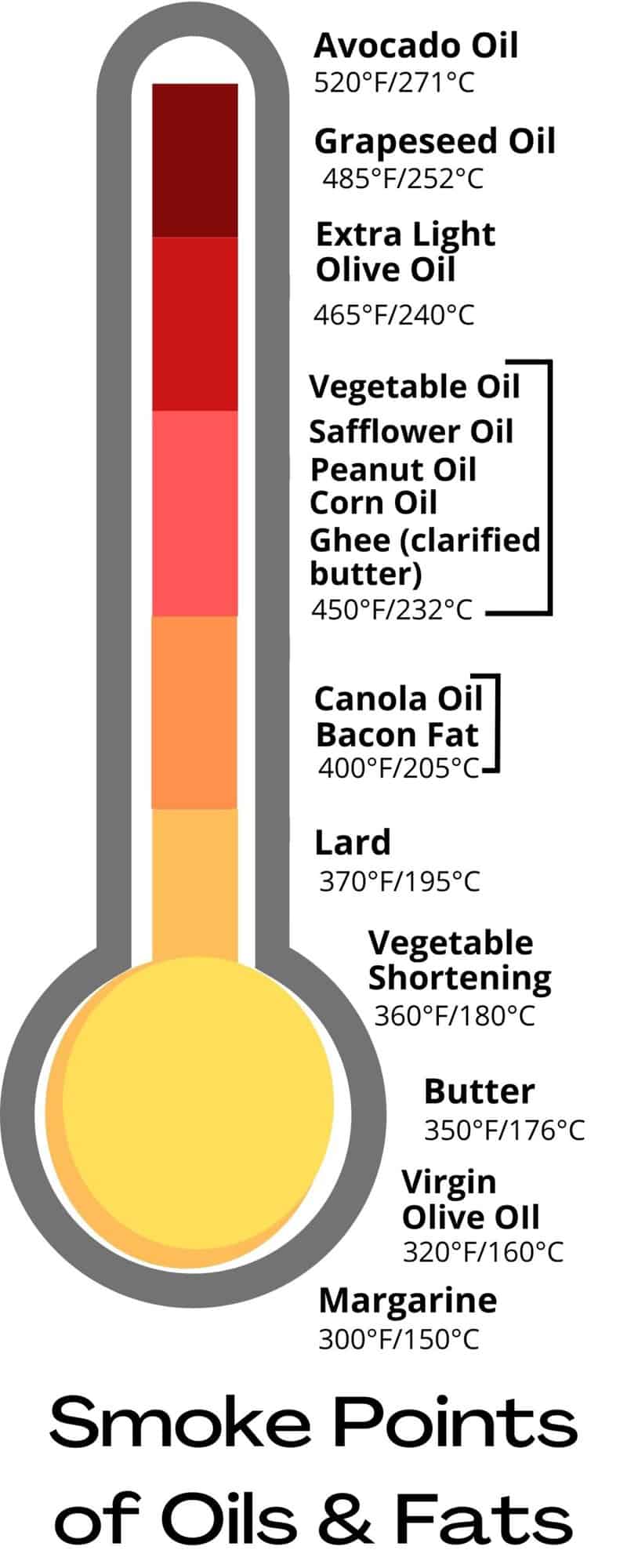
What is a smoke point? A smoke point is the temperature at which an oil or fat starts to burn and smoke. The oil will impart a bitter and burnt flavor to whatever it flavor becomes bitter and burnt.
If you intend to make a brown or dark brown roux you’d be well advised to use an oil with a higher smoke point so your roux is less likely to burn during the long cook time.
Please take a look at this smoke point guide with common oils and fats before selecting one for your roux.
Price
If you’re making a dark brown roux you might think you want to use avocado or grapeseed oil because of their high smoke point and neutral flavor! While these oils will work great for a roux, these oils can be quite expensive. You may find that you prefer vegetable oil, which still has a relatively high smoke point and neutral flavor, but at a much more affordable price point.
Availability
In modern times this is not nearly as common an issue as it once was. But the availability used to influence cooking so much! For example, a Creole gumbo is usually made with butter and a Cajun roux is typically made with oil or lard. This is because of availability! The Creoles traditionally lived in the city where they had access to luxuries like butter. However, the Cajuns usually lived in the more isolated countryside where they had to make do with what they had—typically lard or oil.
Best Oil for a Gumbo Roux
This is a highly debated subject. If you are making a Creole gumbo, butter is the most traditional. It will give a delicious flavor in a blond roux.
In a Cajun gumbo, you’ll want to use an oil that has a neutral flavor with a high smoke point. I typically go for vegetable oil for its affordability and the fact that I always have it on hand.
Olive oil, while often popular in cooking, is not recommended for a gumbo roux. Virgin olive oil has a relatively low smoke point at 320 degrees Fahrenheit and does not have a neutral flavor. It tends to burn easily and gives the roux an unpleasant flavor.
Creole vs. Cajun Roux
When it comes to gumbo, butter is traditionally used in a Creole gumbo and oil or lard are typically used in a Cajun gumbo.
I typically prefer to use a Cajun gumbo roux (a dark brown roux) in gumbo because of the rich, complex flavor it gives gumbo but in a Creole gumbo recipe—yes, I’m mixing and matching here.
When making a gumbo with butter you will end up with a blond roux. Do not want to attempt to try to get a dark roux with butter, you will burn your roux. Butter has a low smoke point and the milk solids in it, which also give it great flavor, burn easily.
Check out our full post on Cajun vs. Creole and our recipe for Creole Chicken and Sausage gumbo!
Roux Color Guide
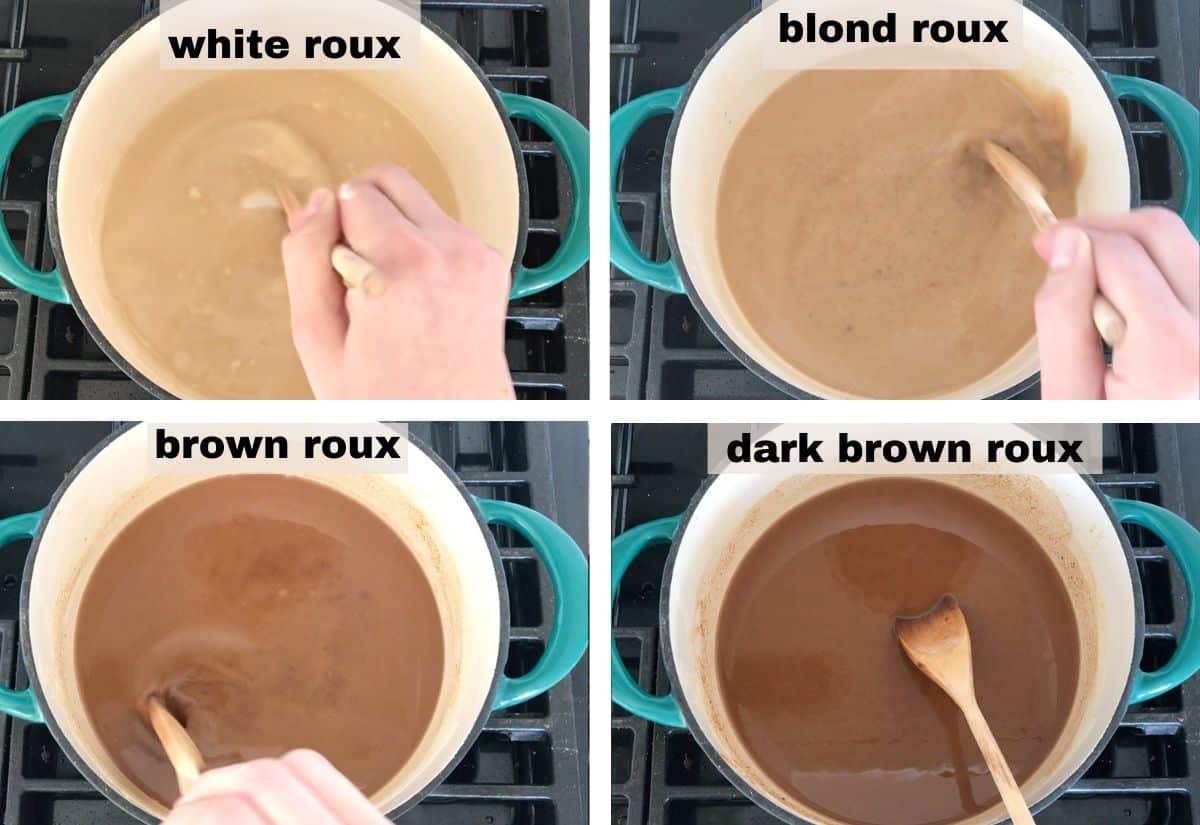
A roux’s color transitions from white (light tan color) to blond (peanut butter color) to brown (milk chocolate color) to dark brown.
Common questions about roux color are:
What should a roux look like?
A roux will look like one of the variations above depending on what kind of roux you are making!
Can a gumbo roux be light? How dark should a gumbo roux be?
As we’ve talked about throughout this article, a Creole gumbo roux tends to be lighter—a blond roux the color of peanut butter. A Cajun roux will be somewhere close to the brown or dark brown roux color.
What Kind of Roux is Right For Your Recipe?
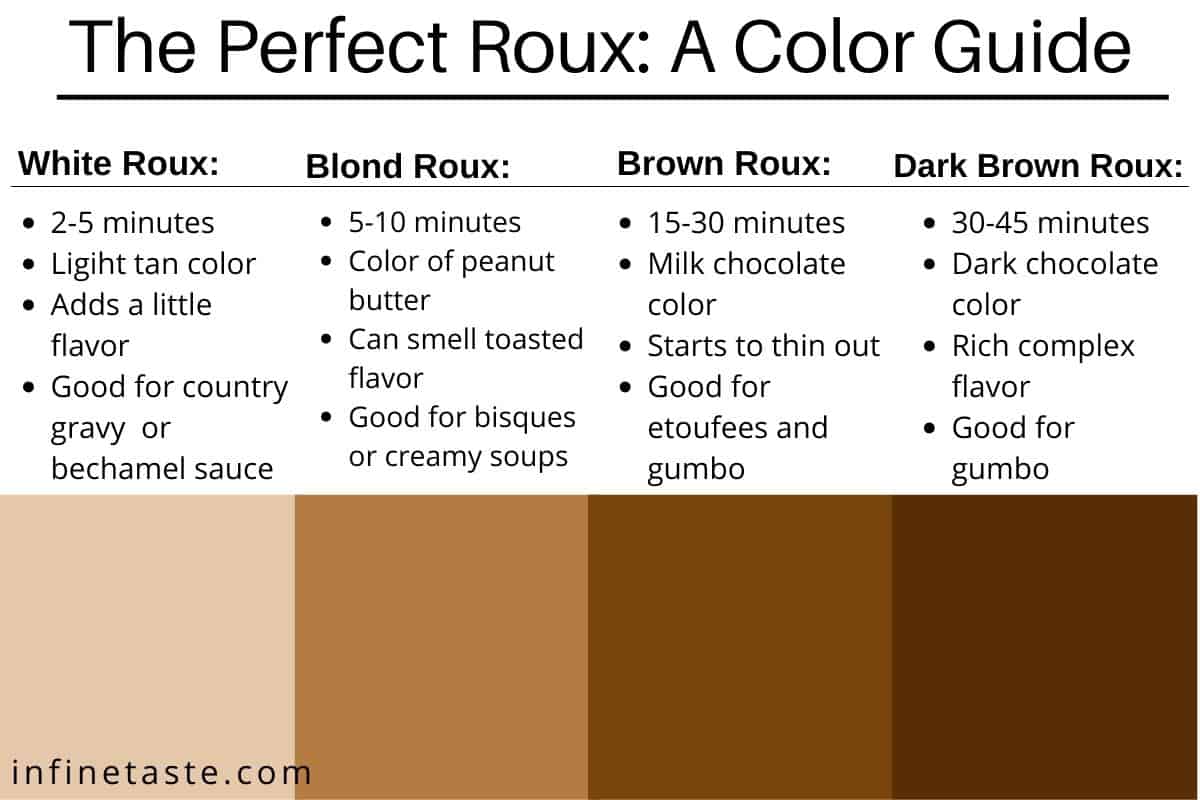
Different recipes warrant different roux! We’re giving you a quick summary of each roux flavor and what you might use it for. Don’t forget to pin this color guide for later
White Roux
A white roux is cooked just enough to remove the starchy flavor form the flour. It is neutral flavored and works wonderfully as a thickener in recipes. It is ideal for sauces, creamy soups, country gravy, bechamel sauce, and chowders. A white roux takes 2-5 minutes to achieve.
Blond Roux
A blond roux has a slightly nuttier flavor as the flour is toasted together with the oil or fat. It still thickens recipes and is great for sauces, bisques, creamy soups, and creole gumbo. A blond roux takes 5-10 minutes to achieve.
Brown Roux
A brown roux has a nutty flavor and at this point it begins to lose its ability to thicken recipes. It is ideal for etouffees, gumbo, seafood gumbo, gravies, and espagnole sauce. A brown roux takes 15-30 minutes to achieve.
Dark Brown Roux
A dark brown roux has a rich complex flavor. It no longer helps thicken recipes. It is mostly ideal for gumbo and seafood gumbo. A dark brown roux takes 30-45 minutes to achieve—it can take longer depending on your heat level—low and slow is best.
How to Make a Roux

- Take a heavy-bottomed pot place it over medium-low heat. Add your fat, oil, or butter (your choice!) to the pot with flour.
- Whisk together until you have no lumps. Continue to stir the roux constantly until you reach the desired color.
Frequently Asked Questions (FAQs)
I do not recommend you use olive oil in a roux. Olive oil burns easily and gives an unpleasant flavor. See our guide above about selecting an appropriate oil or fat for your roux.
It can take anywhere from 2-45+ minutes to make a roux depending on what kind of roux you’d like to make and what level of heat you cook it over.
White Roux: 2-5 minutes
Blond Roux: 5-10 minutes
Brown Roux: 15-30 minutes
Dark Brown Roux: 30-45 minutes
With roux, the longer it is cooked the thinner the consistency gets. White and blond roux are much thicker than a brown or dark brown roux. A standard roux calls for a 1:1 ratio of flour to fat. When I make a dark brown roux for my gumbo, I will up the flour called for by about 25% to a little extra body to the gumbo.
For example, if I would normally use 1 cup of flour to 1 cup of oil in my gumbo roux, I will use 1 ¼ cups of flour to 1 cup of oil.
If you see any black bits or dark/black streaks in your roux, that is usually a good sign that it has burned. Once a gumbo roux has burned there is no chance of saving it. It is best to discard and start over.
It is best to cook a roux of low or medium heat. Never go any higher than medium! Low and slow is best. This ensures your roux has little risk of burning.
Expert Tips
- Use a Heavy Bottomed Pot. Using a heavy bottomed pot will help prevent your roux from burning. I prefer cast iron or enamel coated cast iron pots or pans to make my roux. Cast iron is not only thick, but it heats evenly and you won’t get hot spots. Thinner pots, like stock pots, are almost a guarantee you will burn the roux.
- Cook over Low or Medium heat. Never high. It’s tempting to turn the heat up to high when making a roux to speed up the process, but you run the risk of burning your roux. Remember: it is better to take your time cooking your roux than burning it and having to start over.
- Whisk and Watch Constantly. I usually whisk my roux at the beginning and then change to a wooden spoon with a flat edge. Stirring constantly will keep your roux smooth, but also keep any bits from sticking to the bottom and burning.
- Be patient. It’s tempting to multitask and start chopping vegetables, but the second you do I promise you’ll burn your roux and be scrubbing a scorched pan.
- Make it Ahead of Time. You can make your roux ahead of time and store it until you need it. Cool the roux and store it in an airtight container. If using a vegetable oil, the roux will keep at room temperature for several weeks, even a month. If using butter or fat, store it in an airtight container in the fridge for up to two months.
We think You'll Enjoy These Posts Too:
P.S. If you tried this recipe or any other In Fine Taste recipe take a second and rate it below! We love hearing what you think. Let’s stay in touch! Sign up for our newsletter or follow us on Facebook, Instagram, TikTok, Youtube or Pinterest for more recipe ideas.

The Secret to the Perfect Roux (and the perfect GUMBO ROUX!)
Ingredients
- 1 cup butter, oil, or lard
- 1- 1.25 cups flour if using an oil for your roux, you may need 1.25 cups flour to help thicken it.
Instructions
- Take a heavy-bottomed pot place it over medium-low heat. Add your fat, oil, or butter (your choice!) to the pot with flour.
- Whisk together until you have no lumps. Continue to stir the roux constantly until you reach the desired color.
Video
Nutrition
Test out your Roux Skills on these other recipes!
Originally posted February 27, 2018
Check out our webstory for this post.



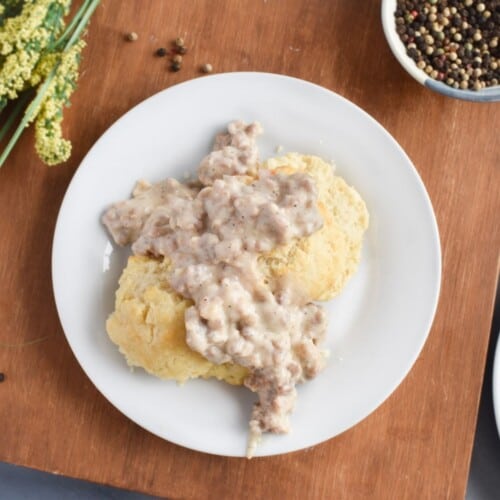


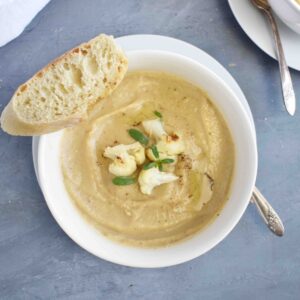
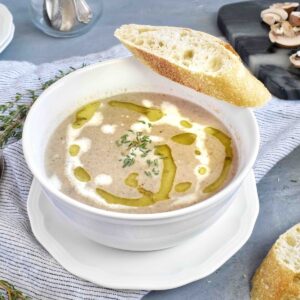
Glenn
The darker the rough the less thickening power it has. I cook mine to a light pecan color and if I want it darker just add a little kitchen bouquet.
Amanda
This was my first attempt at making roux - it came out great! I wish I had more ghee, because I’m trying to thicken my tomato 🍅 sauce. Thanks so much for your awesome post! The cast iron pan over low heat and keep stirring - I really gained some confidence on this one!
jlbs
I'd like to know the recipe using Gluten-Free flour. Thank you.
In Fine Taste
Hi! From what I understand, you should be able to use a gluten-free all-purpose flour to make a roux, the same way you'd make a traditional roux. The only difference is that you should not take the roux past that peanut butter color stage. It will start tasting burned and bitter if you do.
- Alyssa
Bill
This was a great recipe. Virtually the same as all the other recipes, but there was so much detail and explanation that it helped me understand my previous failures. It did not finish as dark as I wanted, but my Couvillion was spectacular so I don’t think it mattered much. Thank you for the guidance.
Carla
Very helpful and easy to follow. There was much information given but it was not overwhelming.
Thank you
Kathe
Yes good info because I learned about the different oils. I wanted mine darker but added some ghee to the avocado oil and still kept it on the blonder side.
Carla Matlock
Have you ever canned your roux for later use?
In Fine Taste
Hi Carla,
No, I've never tried canning it before! I know a lot of people freeze their roux to use later, which I have done. If you do try canning it, I'd love to hear how it turns out!
If you want to freeze it, cool the roux completely and place in a freezer gallon/quart sized bag. Try to remove as much air as possible to prevent any freezer burn. It is best used within 3 months in a normal freezer or 9 months in a deep freezer.
- Alyssa
Seafood Queen
Loved the information! The visuals were appealing and works so much better than words alone, when making for the first time. Fine points on type of pans to use and another visual along with where to purchase and cost of pan.